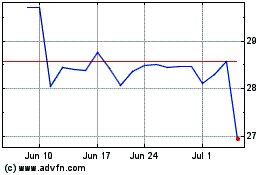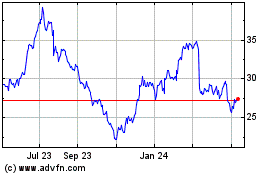By Andy Pasztor
A congressional panel issued a report documenting what it
determined were safety-oversight lapses by the Federal Aviation
Administration, from agency intimidation of federally protected
whistleblowers to lax policing of maintenance errors.
The 101-page document, released Friday by the Senate Commerce
committee, is sharply critical of FAA leadership's handling of
numerous matters over several years. The findings stem from the
broadest review of agency enforcement efforts conducted in the wake
of two fatal crashes of Boeing Co.'s 737 MAX jets.
Concluding that systemic FAA deficiencies pose an "unnecessary
risk to the flying public," the report cited a pattern of agency
managers avoiding responsibility for failures to ensure proper
staff training. Managers also undermined or overruled enforcement
decisions of some inspectors, investigators determined.
"When inspectors pushed back," according to the report, "they
were investigated and in some cases reassigned."
After examining some 13,000 pages of documents and interviewing
dozens of agency employees, investigators described a "failed FAA
safety management culture" tending to favor companies over FAA
staff and "often accompanied by retaliation against those who
report safety violations."
Specifics raised in the report pertain to two major U.S.
passenger carriers, a number of big cargo airlines and smaller
commercial-aircraft and helicopter operators.
The FAA said it was reviewing the information, but sounded a
skeptical note. The committee, according to the FAA, acknowledges
its report contains a number of unsubstantiated allegations.
A string of earlier reports by House lawmakers, accident
investigators and independent safety experts focused on the MAX's
flawed flight-control system, which led to 346 fatalities and a
nearly two-year global grounding of the fleet.
The strongest and newest details in the latest safety review,
however, related to other aspects of the FAA's dealings with the
industry. Investigators found what they described as agency abuses
of voluntary disclosure practices the FAA routinely relies on to
learn of hazards discovered by carriers, pilots and mechanics.
FAA inspectors "were pressured or coerced by FAA managers" to
accept such voluntary disclosures even though they clearly fell
outside the bounds of program procedures and requirements,
according to the report.
The report lays out instances of Southwest Airlines exerting
"improper influence on the FAA to gain favorable treatment."
Early this year, an FAA inspector reported that after pilots on
a Southwest flight experienced persistent flight-control problems
during takeoff, cruise and descent, the crew opted to fly another
leg with the malfunctioning plane instead of alerting maintenance
personnel. The second flight was beset by the same handling
difficulties.
"Despite the intentional nature of the event" which should have
precluded protections under voluntary disclosures, according to the
report, Southwest successfully argued the behavior of the crew fit
the program's guidelines and they shouldn't be subject to
punishment.
An improperly done previous repair turned out to be the root
cause of the control issue, which could have resulted in a crash,
according to the report. But the inspector who originally
investigated the flights and the flawed repair, according to the
report, told the committee he was convinced Southwest was gaming
the system and provided misleading information to the FAA.
Southwest said it was aware of the report and has used earlier
discussion of some issues to improve internal practices, adding the
carrier "maintains a culture of compliance" and recognizes "the
safety of our operation as the most important thing we do." A
spokeswoman added "we absolutely disagree with allegations of
improper influence," because Southwest didn't "inhibit or interfere
with the FAA's ability to exercise oversight and investigative
responsibilities."
In another section, the Senate report indicated Boeing officials
tried to skew FAA ground-simulator tests in their favor in July
2019, months after the second 737 MAX accident. These officials,
according to investigators, "inappropriately coached" FAA pilots on
how to respond swiftly to simulated emergencies. According to the
report, FAA and Boeing officials "had established a predetermined
outcome to reaffirm" Boeing's initial design assumptions and "were
attempting to cover up important information that may have
contributed to the 737 MAX tragedies."
Boeing's activities failed to persuade the FAA to quickly return
the MAX to service, FAA officials have told House and Senate
investigators. Ground-simulator testing later the same day by a
more-senior FAA pilot eventually led the agency to demand major
software and training fixes that ended up delaying resumption of
flights for more than a year.
The FAA's statement said the agency "conducted a thorough and
deliberate review of the 737 MAX" before lifting the grounding
order last month. The FAA added all safety issues have been fully
addressed "through the design changes required and independently
approved by the FAA," along with foreign regulators.
Boeing said lessons from the dual MAX crashes "have reshaped our
company and further focused our attention on our core values of
safety, quality and integrity."
Following a 20-month probe, Senate investigators mentioned
persistent difficulties getting access to government documents and
interviewing FAA employees. The report described some testimony as
conflicting and misleading. "The level of cooperation by the FAA"
and its parent agency, the Department of Transportation "has been
unacceptable and at times has bordered on obstructive," according
to the committee.
Write to Andy Pasztor at andy.pasztor@wsj.com
(END) Dow Jones Newswires
December 20, 2020 08:36 ET (13:36 GMT)
Copyright (c) 2020 Dow Jones & Company, Inc.
Southwest Airlines (NYSE:LUV)
Historical Stock Chart
From Mar 2024 to Apr 2024

Southwest Airlines (NYSE:LUV)
Historical Stock Chart
From Apr 2023 to Apr 2024
